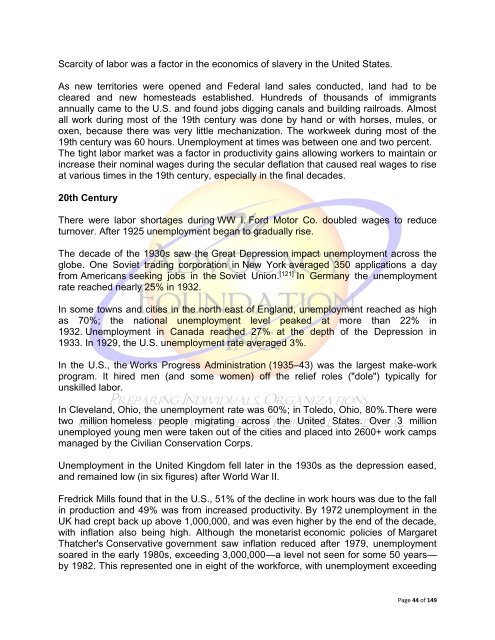Hidden Unemployment
Hidden Unemployment
Hidden Unemployment
You also want an ePaper? Increase the reach of your titles
YUMPU automatically turns print PDFs into web optimized ePapers that Google loves.
Scarcity of labor was a factor in the economics of slavery in the United States.<br />
As new territories were opened and Federal land sales conducted, land had to be<br />
cleared and new homesteads established. Hundreds of thousands of immigrants<br />
annually came to the U.S. and found jobs digging canals and building railroads. Almost<br />
all work during most of the 19th century was done by hand or with horses, mules, or<br />
oxen, because there was very little mechanization. The workweek during most of the<br />
19th century was 60 hours. <strong>Unemployment</strong> at times was between one and two percent.<br />
The tight labor market was a factor in productivity gains allowing workers to maintain or<br />
increase their nominal wages during the secular deflation that caused real wages to rise<br />
at various times in the 19th century, especially in the final decades.<br />
20th Century<br />
There were labor shortages during WW I. Ford Motor Co. doubled wages to reduce<br />
turnover. After 1925 unemployment began to gradually rise.<br />
The decade of the 1930s saw the Great Depression impact unemployment across the<br />
globe. One Soviet trading corporation in New York averaged 350 applications a day<br />
from Americans seeking jobs in the Soviet Union. [121] In Germany the unemployment<br />
rate reached nearly 25% in 1932.<br />
In some towns and cities in the north east of England, unemployment reached as high<br />
as 70%; the national unemployment level peaked at more than 22% in<br />
1932. <strong>Unemployment</strong> in Canada reached 27% at the depth of the Depression in<br />
1933. In 1929, the U.S. unemployment rate averaged 3%.<br />
In the U.S., the Works Progress Administration (1935–43) was the largest make-work<br />
program. It hired men (and some women) off the relief roles ("dole") typically for<br />
unskilled labor.<br />
In Cleveland, Ohio, the unemployment rate was 60%; in Toledo, Ohio, 80%.There were<br />
two million homeless people migrating across the United States. Over 3 million<br />
unemployed young men were taken out of the cities and placed into 2600+ work camps<br />
managed by the Civilian Conservation Corps.<br />
<strong>Unemployment</strong> in the United Kingdom fell later in the 1930s as the depression eased,<br />
and remained low (in six figures) after World War II.<br />
Fredrick Mills found that in the U.S., 51% of the decline in work hours was due to the fall<br />
in production and 49% was from increased productivity. By 1972 unemployment in the<br />
UK had crept back up above 1,000,000, and was even higher by the end of the decade,<br />
with inflation also being high. Although the monetarist economic policies of Margaret<br />
Thatcher's Conservative government saw inflation reduced after 1979, unemployment<br />
soared in the early 1980s, exceeding 3,000,000—a level not seen for some 50 years—<br />
by 1982. This represented one in eight of the workforce, with unemployment exceeding<br />
Page 44 of 149

















